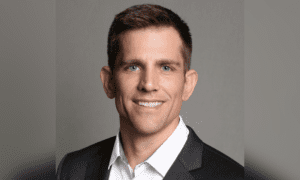"The future is here; it’s just uneven"

“The future is here; it’s just uneven” | Insurance Business America
Risk Management News
“The future is here; it’s just uneven”
ACORD CEO on global connectivity, AI, and the risk managers who are “making it happen”
Risk Management News
By
Kenneth Araullo
There is a question that Bill Pieroni, CEO of the Association for Cooperative Operations Research and Development (ACORD), has been waiting to be asked for 30 years. It’s a vitally important question, Pieroni said – but no one has ever asked it.
That is, until he sat down with Insurance Business’s Corporate Risk channel. This question is about risk managers and their role in this ever-changing industry. In conversation, Pieroni said that in this world dominated by capitalism and “the invisible hand,” it falls upon the risk managers to decide just where this insurance ship will sail next.
“In a way, what you’re really asking is: the customer, what role does the customer have in all of this? And too many times people do not think of the customer, and that the risk manager is the buyer. What a wonderful, important question,” Pieroni remarked. “It’s the digitally mature carriers that are growing faster and have more profit. Why? It’s the risk managers that are making that happen. They’re the force that’s doing that. Why are digital laggards not growing as fast? It’s because risk managers aren’t selecting them. That’s why it’s happening, it’s not magic.”
This point about digitalization stems from ACORD’s own findings; Pieroni said that in the organization’s annual study that looks at insurers worldwide, 25% represents the cream of the crop. Across lines, businesses, and specializations, their unifying aspect is their relatively high levels of digital maturity – in Pieroni’s own words, “they’re in the two highest categories out of the five levels we identified.”
“Then you’ve got those that are frozen in the past. And that’s about 15%. Then there are digital laggards. That’s another 10%,” Pieroni said. “We’ve got carriers out there who are extremely digitized, and really do leverage seamless transfer of data. But [at] the other extreme, we’ve got an equal number on a percentage basis where they’re relatively last generation, obsolete, and really manually intensive out there.”
Adding value to insurance, within and between
Over the past 50-plus years, ACORD has been developing data standards around the definition of key insurance elements. These standards have helped support 1,200 standardized transaction types, including all the important cogs in the insurance machine: brokers, agents, carriers, reinsurers, regulatory regimes, and the insureds and their risk managers.
“Think of it as standard definitions involving everything from first notice of loss to verification of coverage to pre-bind policies, underwriting rules, claims – within each of those stakeholders, or in messages between them. In general, it has to do with data, the gathering, synthesis and leverage of data, which is the lifeblood of our industry,” Pieroni said.
And what a lifeblood it is, as data has proven itself to arguably be the most uniquely important aspect in the industry, especially with the dawn of generative artificial intelligence (AI). It’s this data – and the global connectivity that spreads it from one corner of the globe to the other – that has enabled ACORD to support the broader insurance sector today.
“I think that ACORD not only adds a great deal of value within each stakeholder, but we really add a tremendous value between them,” Pieroni said. “Think of a broker binding a policy, whether it’s personal or commercial lines, and then they have to transmit that data to a number of primary carriers in order to get bids. Having a consistent way that that information is gathered and shared; this really makes a broker far more efficient, and far more effective.”
While Pieroni cites both efficiency and effectiveness as the organization’s primary worth, he also notes that the only value that matters is the one sitting on the other end of the transaction.
“The only person that really matters here is the insured, right? Is the insured getting a better solution? Are they getting a better set of risk transfer options, and at a reasonable price?” Pieroni said.
An “uneven” future and the pandemic “time machine”
Assessing the current state of global connectivity, Pieroni said that the current situation is unique due to how “unevenly distributed” the future is. In ACORD’s whitepaper, the top 200 insurers represent 63% of the global premium, out of over 12,000 carriers worldwide. It’s a skewed distribution, but it’s also easy to understand how digitalization has powered the best of the best.
“I think that the future is here, it’s just unevenly distributed,” Pieroni said. “What’s interesting is if you look at our study, those carriers with high levels of digital maturity are growing much faster than the rest of the industry. They’re generating far superior combined ratios, they have extremely high levels of customer satisfaction, and their shareholder returns are significantly greater. We are seeing that higher levels of digital maturity are leading to improved growth, share, economics, and stakeholder satisfaction.”
This future, Pieroni noted, was also somewhat accelerated during the global pandemic. Before COVID hit, ACORD’s data pointed to a reasonably fine performance from digital laggards. In Pieroni’s words, they “had reasonable profitability, reasonable growth, and reasonable shareholder returns.”
“But the pandemic, I think of that as a time machine, where it really accelerated all the forces that were already changing the industry. I think that the industry felt as if it had a lot of time to actually digitize, to think about standards, but the pandemic greatly accelerated everything,” he said.
This major shift has upended everything, and now those digital laggards suffer from a slump. Lower levels of profitability, slower growth, lagging share returns – all these combined to push legacy-powered firms to the bottom of ACORD’s whitepaper. However, Pieroni said that the lack of digitalization also comes with a different set of deficiencies that are not exactly connected to how fast an insurer’s system can be.
“I believe that as important as technology and standards are, the fundamental source of advantage is people – like underwriters, like claims managers. It’s people,” Pieroni said. “If you’re not attracting and retaining high-skill talent, you are going to be at a disadvantage. The insurance industry, in most geographies around the world, they have an average age north of 50. You’re going to have millions of people retiring over the next decade, and certainly over the next two decades, worldwide in most major insurance markets.”
Over the next decade, Pieroni said that the industry will significantly be older and on the verge of retirement, especially since in most geographies around the world insurance is manned by those aged north of 50. Attracting talent is also not the easiest, and from the small pool of talent, it will be much harder to turn heads if you’re technologically lacking.
“People graduating from university today do not tend to pick insurance as a profession. Insurance consistently ranks in the bottom decile. That said, if you’re a technology professional, or an actuary, or a claims professional, a broker, an agent – you’re going to want to work at an organization that has much higher levels of digital maturity,” Pieroni said.
“Believe it or not, my biggest concern is if you’re not bringing the talent in – the technical talent, the domain expertise at underwriting, actuaries, claims – that’s going to be the real issue. Even if you could throw money at the technology, how do you deal with the fact that you didn’t attract talent, because you didn’t realize that’s a real issue? I think that as low as insurance ranks, those with last-generation infrastructures really are not preferred employers, and they’re not getting the top talent,” he said.
A challenge for insurtechs
While digitalization is important, Pieroni said that where you put this digitalization to work matters equally. For this industry, it is essential to wade around the “confusion and hype” and address the aspects that will actually matter.
“I want to make it simple,” Pieroni said. “Seventy percent of premium dollars go out the door through claims. Around 10 to 15% [of the 70%] goes towards adjusting a claim, and the rest of it for the actual payment of the claim. The other 30% of premium dollars are spent in underwriting.”
With this in mind, Pieroni addressed the current insurtech landscape and how, in essence, it is also confused on what really matters. According to him, less than 6% of insurtech investment goes towards underwriting and claims, yet these two areas represent 100% of the expenses. In order to drive efficiency up, he urged the industry to look at claims – make adjudication more efficient, more effective, and make the payment of claims better. Complete this, and he said that we would have already covered a major fraction of the premium dollars.
“Then, think about underwriting expense. Commissions – that’s about 10%. You want to pay the agents and brokers because they add a lot of value. Another 3% goes to taxes. So out of that 30% underwriting expense, let’s say half of it is for agents and brokers and taxes, but that means that 15% is for acquisition and general expenses,” Pieroni said. “My first area of focus would be claims – it’s 70% of premium dollars – then tackle acquisition and general expense by improving the underwriting process. I think it’s that simple; just look at the income statement and balance sheet and look for where the money is.”
“So, for any insurtechs, any technology startups, you want to have a strong value proposition? Claims. If you don’t have claims expertise? Underwriting. If you’re not improving the efficiency or effectiveness of claims or underwriting, you’re not addressing the needs of the industry. If you’re not making these carriers more efficient and more effective, you’re not going to compel them to actually buy your products and improve their viability as a customer,” he said.
On AI, or “applied statistics”
Just like most of the industry, Pieroni had strong feelings about the dawn of useful and meta-shifting generative AI. It “is very real,” he commented, and it is going to have a “transformative impact” on the industry. That said, he did have a few qualms about the way it is being viewed right now.
“I don’t want to trivialize how important AI is with this comment – because as I said, it’s going to transform our industry – but AI is nothing more than applied statistics. It’s applied mathematics,” Pieroni said. “I think there’s lots of confusion out there around its intelligence, and if it’s going to replace people. Simply put, it’s going to augment people. It’s going to make people better, faster, and have a bigger impact for customers, for shareholders, for the carriers. It’s going to be transformative.”
Noting that the hype around it has been nothing short of palpable, Pieroni also wished that it was not viewed as something to be afraid of. In the past year since it has developed, generative AI has been the centre of many debates around ethics and how it can make the human workforce in a few years’ time. Even Hollywood is embroiled in such a debate right now, as the ongoing strike calls for ethical AI use to make sure that performers are protected from having their digital likeness exploited. However, Pieroni is convinced that AI – or applied statistics, as he reiterated every so often – is just something that will augment the human using it.
“There’s lots of hype around it, and it is a big deal, but I don’t want people to think of it as some scary technology that’s going to eliminate people. The recording tool we’re using for this interview right now, your headset that you’re wearing, the computer that you’re going to write this on – none of those are going to replace you, it’s something that makes you better,” Pieroni said.
“The term ‘artificial intelligence’ was coined in 1956, and I wish they never called it artificial intelligence,” he said. “I wish they called it applied statistics. Even when you look at tools like ChatGPT, they’re just large language models, nothing more than statistics. I’m impressed by stochastic non-deterministic models, but they don’t scare me. Just like I feel much safer when my car is driving itself than when I’m driving it. I trust it much more implicitly. So, AI doesn’t frighten me.”
It all comes down to improving individual productivity, Pieroni reiterated, and AI is something that can improve this aspect. Much like a word processor for a writer, a jackhammer for a construction worker, and other technologies that have significantly made our lives easier, AI will do the same. However, much like how an egg cannot be unscrambled, Pieroni also conceded that there was a moment when the technology became commercially available for all which has forever changed the way we work forever.
“Is it going to change work and roles? Sure, you can count on it, but I’m not scared of it. It’s very real, but while it’s transformative, it’s not some frightening technology from science fiction. It’s just math,” he said.
“Understand your role in the Darwinian evolution”
The underinsurance gap remains one of the key challenges for the industry to this day. For someone as experienced as Pieroni, solving this challenge comes with realizing opportunity, a key trait for any firm believer of capitalism – something he confessed to being.
“You look at emerging markets and things like that, what I would say is, let’s let carriers see the opportunity,” Pieroni said. “One of the things that both brokers and carriers like is stability; as much as the industry may be concerned by some regulations, they give them some sense of security. With it, they understand the law, they understand where they’re going to be liable.”
It all starts with opportunity, Pieroni said, and with regulators understanding how important insurance is to economies, especially emerging markets. However, he also urged the industry to remove their rose-tinted glasses when it came to emerging markets.
“What’s interesting to me is, we did a study that found that over the last 10 years, there has been more growth in mature markets, and higher levels of profitability in mature markets than emerging,” Pieroni said. “I know that people intuitively say, ‘lots of opportunity in emerging markets,’ while profitability hasn’t been where it could be. To your point, I would say that over the last decade, there’s more underinsured risk in emerging markets.”
This level of discernment is key to being a good risk manager, and Pieroni circled it back to that age-old question that he has been waiting for in the last three decades.
“What I think risk managers need to do is understand who they’re buying from, what does their balance sheet look like, how is their claims-paying ability,” he said. “A smart risk manager doesn’t want the cheapest price; they want the right price. I can’t afford cheap shoes, because in a way they’re too expensive. They fall apart, and they hurt my feet, and it’ll cost me more in the long run.”
Pieroni argued that the cheapest proposition is something a smart risk manager can never afford, and it is because of this healthy thinking that the industry finds itself in this uneven future today. That said, he also described the industry as a “Darwinian evolution.” Ultimately, it’s in this evolution where the industry will increase its value through the process of natural selection.
“So, my coaching would be: understand your role in the Darwinian evolution of our industry and continue to be discerning, intelligent buyers of risk transfer mechanisms. Great question, never been asked of me. I’ve been dying to give that answer,” Pieroni said.
What are your thoughts on this story? Please feel free to share your comments below.
Keep up with the latest news and events
Join our mailing list, it’s free!





